A Family's Passion
Tuesday, October 15, 2013
In Bangladesh, a family protects a site that might appear on a second century A.D. Greek map
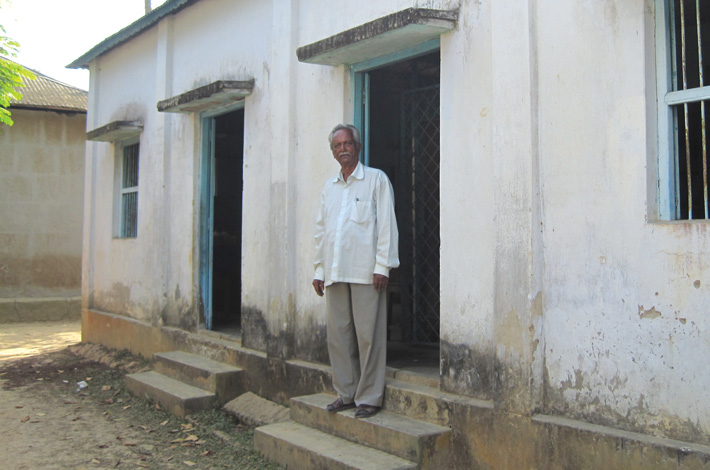
(Courtesy Reema Islam)
Habibulah Pathan stands in front of his home, which is also the location of the small museum he and his father established to safeguard the artifacts they have found.
One morning in 1933, on his way to school in a small village in eastern India, a teacher named Hanif Pathan happened upon a group of construction workers who, while doing some foundation work on a house, had discovered a terracotta pot containing a cache of silver coins. In the days and weeks that followed, Pathan started to look for more coins in a three-mile radius around his village, Bateshwar, in what is now Bangladesh, roughly 40 miles northeast of the capital, Dhaka.
He discovered that the best time to search was after the monsoon season would erode low-lying soil, and he continually came across semiprecious stones and scattered potsherds with intricate designs, simply sticking out of the ground. He learned that other villagers were also finding gems, which they had taken to callingSolaimani pathor, or “stones of the Sulaiman,” the Islamic prophet who wore an onyx pendant to ward off evil.
Pathan spent the next three decades traversing the length of Bateshwar and its neighboring village to the north, Wari. He made an inventory of his findings—which included more pots full of coins—and stored them in his house. Trying to attract the attention of international experts, he submitted countless articles about his finds to newspapers. The day in 1955 that the local Daily Azad published one of his articles, Pathan ran to the classroom of his 15-year-old son, Habibulah, to show him the paper. According to Habibulah, now 73, that was the day when he realized he would eventually be carrying on his father’s passion.
“One day, while walking to school in the rain, I found an amethyst bead,” Habibulah told me last year when I visited the archaeological site known today as Wari-Bateshwar. “I felt as if I had hit upon a king’s ransom. I was so elated that I never took my eyes off the ground from that day onwards. I would look for relics and often found a coin or two to bring to my father. As his eyesight and hearing began receding, I acted as his eyes and ears.”
Hanif Pathan passed away in 1989. Today, Habibulah, also a schoolteacher, lives in the same tin-roofed, concrete house he grew up in and looks after a modest museum in its annex. There, artifacts are piled onto shelves that reach seven feet high. Habibulah is actively involved in present-day excavations archaeologists are carrying on about a five-minute drive from his home.
The Pathan men spent decades wondering what life must have been like for the ancient people who lived in their village thousands of years ago. And yet, despite their efforts, as well as a decade of work by Bangladeshi archaeologists, Wari-Bateshwar remains enigmatic. Some experts believe that in antiquity the site might have been a small trading post located at a low-lying spot near a confluence of rivers on the way to the Bay of Bengal. Others support a different theory, first posited by Hanif Pathan, that Wari-Bateshwar was once a wealthy trade center that helped link the Indian subcontinent to the Mediterranean and Southeast Asia, a city once mentioned by the Greco-Roman scholar Ptolemy and that was included on a map he drew in A.D. 150. The surviving Pathan continues to hope that someday, someone will be able to use the artifacts in his care to solve the mystery of who left them behind. “I have often felt like the cobbler in one of Rabindranath Tagore’s famous poems,” Habibulah told me. “When the Maharaja complained that the streets were too dusty, the cobbler invented shoes…out of necessity. Here, I feel like I guard the artifacts out of a need to preserve history.”
Wari-Bateshwar, as the parcel of land would come to be known, is not, as yet, definitively linked to any South Asian locale mentioned in literary sources or in any documented accounts of travels by ancient traders or soldiers. The Pathans, in their exuberance, believed it was the ancient city called Sounagoura, identified by Ptolemy in his second-century a.d. work Geography. “Ptolemy mentioned many cities on the subcontinent that are now lost,” says Sufi Mustafizur Rahman, executive director of the archaeological research center Oitihya Onneswan and an archaeologist at Jahangirnagar University outside of Dhaka, who has been excavating at Wari-Bateshwar since 2000. “Now archaeologists are trying to find them.”
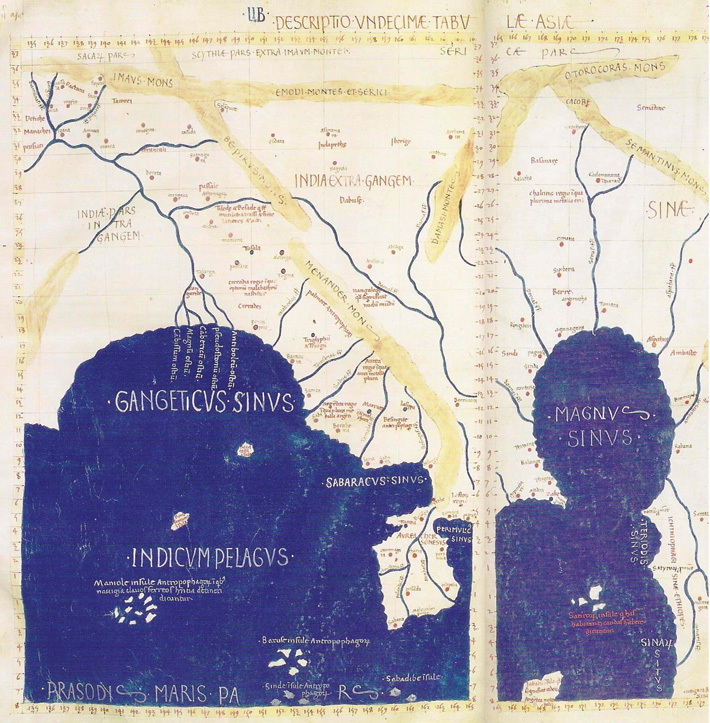
(Wikimedia Commons)
Some archaeologists speculate that Wari-Bateshwar was once the city of Sounagoura, an ancient trade center included by the scholar Ptolemy on a map in his second-century a.d. work Geography, seen here in a 15th-century edition.
According to Ptolemy, Sounagoura sat on the Brahmaputra River’s right bank and was an emporium, which, during the Roman Empire, indicated that Roman merchants had set up a trading colony there. The Brahmaputra River flowed down from the Himalayas and to the east of Wari-Bateshwar before joining the Meghna River on its way to the Bay of Bengal. This would have put Wari-Bateshwar, at that time, directly in the region Ptolemy described. After an earthquake in 1783, the Brahmaputra changed its course, no longer passing by Wari-Bateshwar.
Today, the modern villages of Wari and Bateshwar sit on high mounds interrupted by low marshlands, creating an undulating landscape. The marshy areas, with their small rivers and canals, are likely remnants of the former course of the Brahmaputra. The area is within the Ganges River Delta, one of the most dynamic deltas anywhere in the world, says Monica Smith, an archaeologist at the University of California, Los Angeles, who has dug extensively in the Indian subcontinent. “There have been major shifts and minor shifts, and every year the monsoon rewrites the landscape,” causing nearby rivers to flood the lowlands, she explains. “It’s incredibly dramatic.”
In the late 1990s, more than 60 years after Hanif Pathan alerted his local newspaper to the discovery of the pot of coins, attempts to excavate Wari-Bateshwar and assess whether or not it could be Sounagoura, finally began. Millennia of river shifts and floods make reading the record at Wari-Bateshwar difficult, as artifacts have been uncovered and others have shifted in the earth. “In Bangladesh, most of the sites are above the land,” says Rahman. He references sites such as Mahasthangarh, a large fortified city built high on mounds that dates to the third century B.C. and is located roughly 150 miles northwest of Wari-Bateshwar.
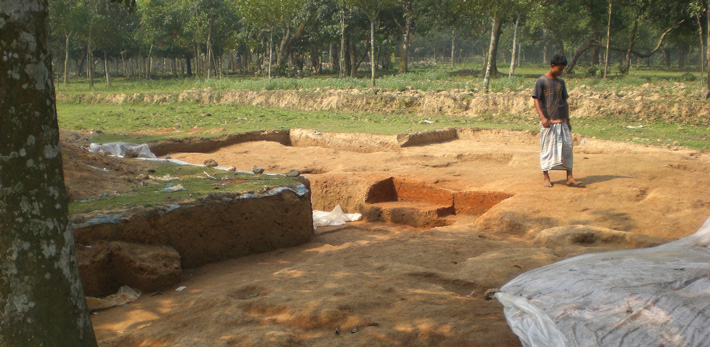
(Wikimedia Commons, Photo: user: omarshehab)
When archaeologists began excavating at Wari-Bateshwar just over a decade ago, they exposed several brick structures, including two fortifications and a feature interpreted as a road, that suggest it once may have been an urban center.
It is known that cities first appeared on the other side of the Indian subcontinent in the Indus Valley around 2500 B.C., at sites such as Mohenjo-Daro and Harappa. After 1800 B.C., cities are nowhere to be found on the subcontinent, until 1,000 years later, when large, fortified settlements, such as Mahasthangarh, begin to appear in the region around the Ganges and Jamuna rivers. Structures uncovered by archaeologists at Wari-Bateshwar seem, in fact, to indicate that it was once an urban center.
Two fortifications found at Wari-Bateshwar support this idea. One has four earthen ramparts that form the perimeter of Wari, enclosing more than 80 acres. An outer fortification, shaped like a check mark, sits to the south in Bateshwar, enclosing the inner fort with the help of a canal to the north and a small river to the east. Rahman also believes a 600-by-16-foot compacted section of the site was once a road built of lime and brick dust. However, local lore suggests the outer rampart is only 500 years old.
Charcoal found at the site has been radiocarbon dated to 450 B.C., and Rahman dates the bulk of what has been found at Wari-Bateshwar to the Indian subcontinent’s Early Historic Phase, which lasted a thousand years beginning in the sixth century B.C. One exception, however, is what Rahman speculates is a pit dwelling found below the Early Historic levels of the site. It is oval in shape and measures about eight-and-a-half feet long, seven feet wide, and slightly more than one-and-a-half feet deep with a red mud floor, a well, a granary, and a hearth. While the dwelling indicates the site is even older than believed, critics argue that the location of the pit would have been underwater 3,000 years ago.
Archaeologists seem to agree that Wari-Bateshwar was inhabited, in some way, by the beginning of the third century B.C. and abandoned by the third century A.D. Those dates are arrived at by comparing artifacts found at Wari-Bateshwar to similar ones found around the subcontinent. Hundreds of silver punch-marked coins have been found at Wari-Bateshwar, beginning with those discovered by the construction workers who attracted Hanif Pathan’s attention 80 years ago. The circular and square coins bear multiple impressions of shapes such as the sun, fish, and boats. The silver coins are very light, with nearly 15 of them needed to make up an ounce. These items link Wari-Bateshwar with the Mauryan Empire, which used punch-marked coins as its national currency. The Mauryans ruled from the late fourth century to the early second century B.C. and was the largest empire in South Asia, reaching as far west as southeastern Iran, with a population of more than 50 million people. The empire developed extensive trade networks to both the west, with the Greeks and Romans, and east into Southeast Asia. If Wari-Bateshwar were actually part of the Mauryan Empire, it may have had the clout to be Ptolemy’s trading hub, Sounagoura.
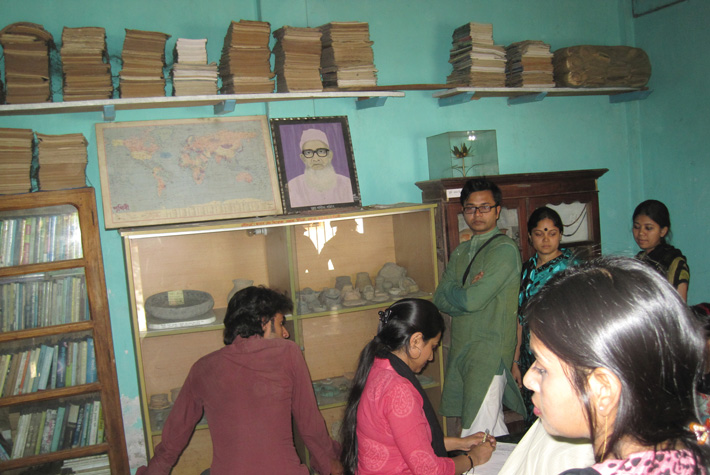
(Courtesy Reema Islam)
Visitors sign the guestbook at the museum maintained by Habibulah Pathan. A portrait of his father, Hanif Pathan, can be seen resting atop a display case.
Rahman and his mentor, the noted scholar of ancient India Dilip K. Chakrabarti, a professor at the University of Cambridge, believe that Wari-Bateshwar’s trade network also reached the Mediterranean. They hold up as their proof a second class of beads, so-called Indo-Pacific monochrome glass beads, several of which were found at the site. Indo-Pacific beads were first made at the site of Arikamedu in southern India during the third century B.C. In the first century A.D., Rahman believes Roman merchants set up an emporium there, as well as at three other port cities in Asia: Mantai in modern-day Sri Lanka, Kion Thom in Thailand, and Oc-Eo in Vietnam.
Indo-Pacific beads could have been imported to Wari-Bateshwar. With its evidence of urbanization, a strong claim to being a port at a confluence of rivers, and artifacts indicating trade, most importantly Indo-Pacific beads, perhaps Wari-Bateshwar belongs on the list of emporia.
At first blush, all the ingredients appear to be in place. Rahman asserts, “Wari-Bateshwar was Sounagoura.” Chakrabarti, too, is a believer. He notes that the recovery of rouletted ware—which has shapes such as wedges or diamonds in circular patterns on its surface—from Wari-Bateshwar connects it to trade with the southern end of the Indian subcontinent and with Southeast Asia, while the Indo-Pacific beads link it to the Mediterranean.
Some, however, disagree that the evidence concerning trade with the Romans indicates they had a presence at the site. “Indeed there are some beads of likely Mediterranean origin in Wari-Bateshwar,” agrees Jean-François Salles, an archaeologist at the French Institute for the Near East, who has dug extensively at Mahasthangarh. “But it is generally assumed that very few, if any, Roman ships ever reached the northern Bay of Bengal.”
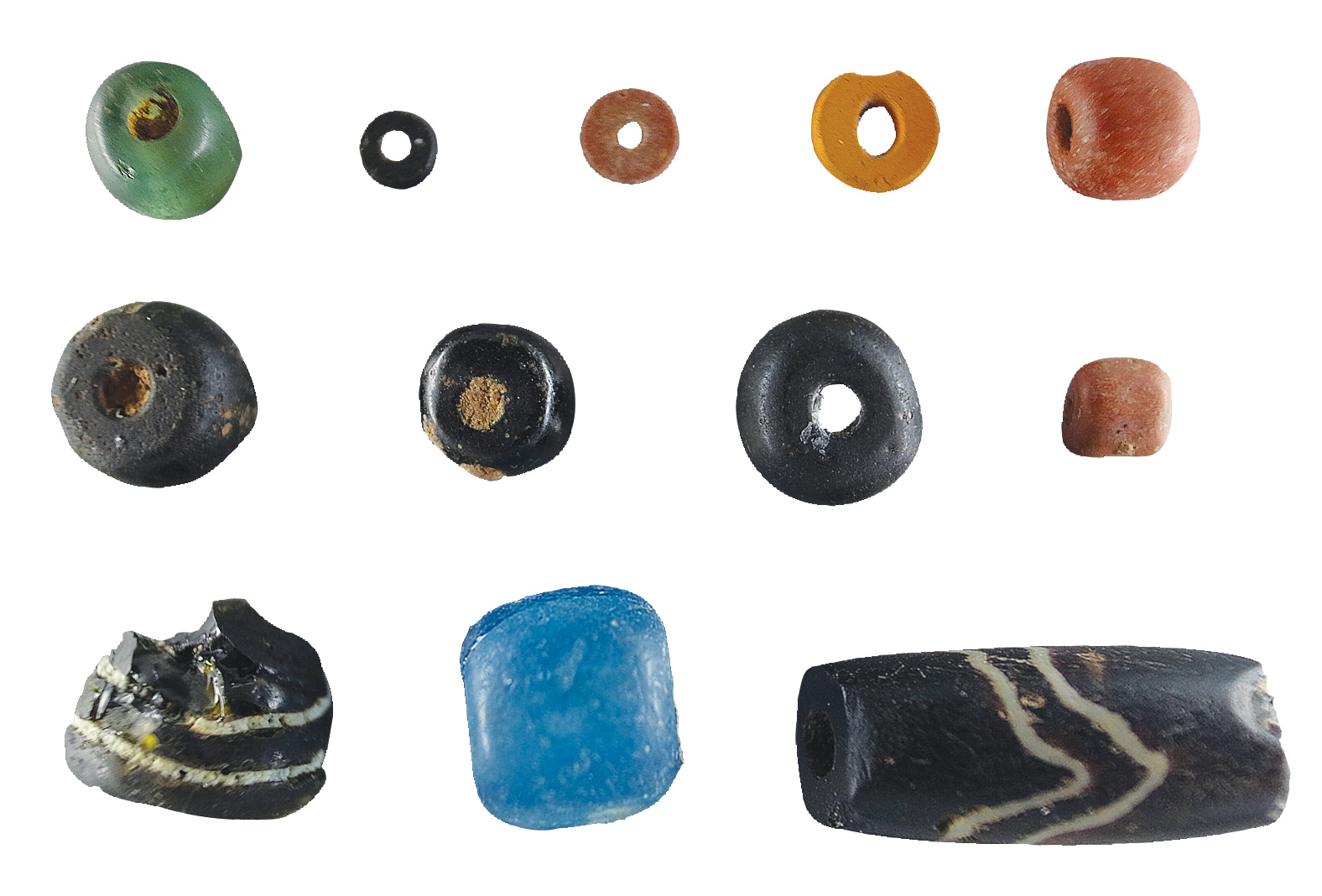
(Courtesy James Lankton, University College London Institute of Archaeology)
Hundreds of glass beads were found at Wari-Bateshwar, including some that may be Indo-Pacific monochrome glass beads (top row), a possible indication of trade with the Roman Empire.
At the end of the day, as far as many Bangladeshis are concerned, it may not matter whether Wari-Bateshwar is found to have been Sounagoura. The beads, coins, and potsherds from the site will continue to capture their imaginations. Hanif Pathan was inspired to collect them, and his son remains inspired to fastidiously look after them. After 55 years of guarding Wari-Bateshwar’s past, Habibulah has begun to identify with another of the great poet Rabindranath Tagore’s characters. “Khepa khuje fere poroshpathor,” he says, quoting a passage that translates to “the madman searches for the eternal stone.” “I may not have discovered the eternal stone,” he says, “but I have found treasures of our lost heritage.”
Reema Islam is a writer based in Dhaka, Bangladesh.
No comments:
Post a Comment